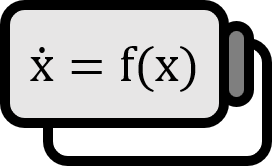Autonomous Systems: Flow and Time-T Maps
Definition 1
Flow
Given a space $X$ and a function $f : X \to X$, suppose we have the following vector field presented as a differential equation. $$ \dot{x} = f(x) $$ For a time variable $t$ and an initial value $x_{0}$, the solution to the autonomous differential equation is called a flow, which is denoted as $F(t, x_{0})$. For a fixed unit time $t = T$, $F_{T}(x) := F(T,x)$ is called a time-$T$ map.
Time Evolution
Regarding the projection $P : X \to \mathbb{R}^{1}$ that typically retains only one coordinate, when $P \left( F \left( t, x_{0} \right) \right)$ is viewed as a function of time $t$, it is also called time evolution.
Description
A flow is also referred to as a trajectory or a phase space. [ NOTE: This is a homonym with the phase space generally mentioned in mathematics, but conceptually, there is no major correlation. ]
From its definition, it can be observed that the flow $F$ describes changes according to $t$ by fixing the initial value $x_{0}$. The time-$T$ map was introduced to handle continuous dynamical systems with maps, originally expressed through differential equations. This allows the discussion in multidimensional maps to be extended to differential equations.
Example
Let’s consider a simple autonomous system such as $\dot{x} = x$: Since the solution to this system is simply $x = x_{0} e^{t}$, the flow of this system for an initial value $x_{0}$ would be $F(t,x_{0}) = x_{0} e^{t}$. Meanwhile, without fixing the initial value, a system that starts from $x$ is verified through the time-$T$ map when time $T$ has passed. The time-$T$ map maps $x$ to $x e^{T}$ after time $T$ has passed as follows: $$ F_{T} : x \mapsto x e^{T} $$ Although it might not be a commonly used expression in dynamics, if one wishes to represent it like a general multidimensional map, the following equation could be formed: $$ F_{T+1} (x) = F_{1} \left( F_{T}(x) \right) $$
Yorke. (1996). CHAOS: An Introduction to Dynamical Systems: p277. ↩︎
